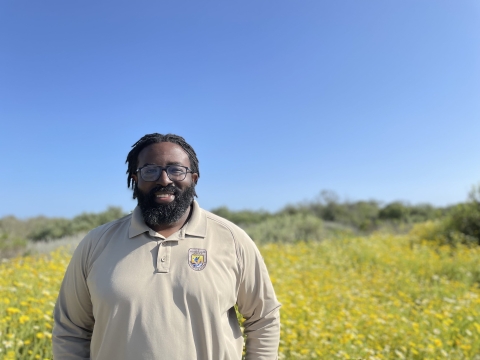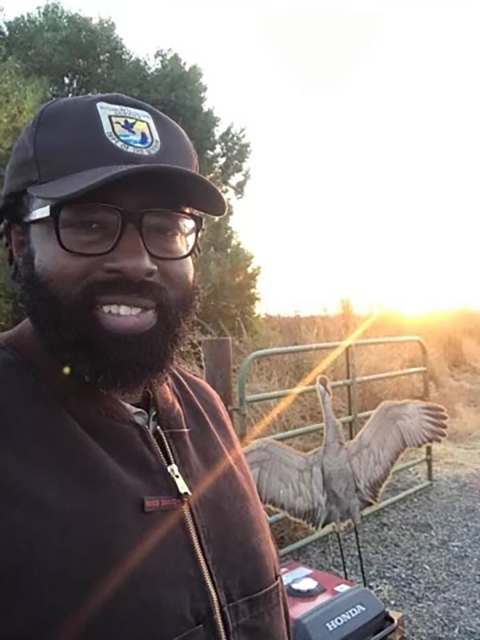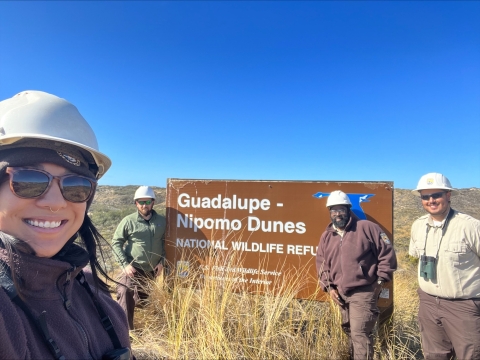During his childhood summers in Fort Worth, Texas, Nicholas Stanley would regularly get woken up by his grandmother for full days of fishing. She would strap down five long cane poles on top of her minivan and drive them to wherever the fish were biting, and she and Nick would sit along the riverbank for hours until they had caught their limit before heading home to have themselves a delicious fish fry. He fondly credits his grandmother for inspiring him to fish, chase bugs, and embrace the landscapes and wildlife around him at an early age.
Following these warm memories, Nicholas, who goes by Nick, attended Grambling State University, a historically Black university in Louisiana to pursue a career working with animals. After learning about the university’s wildlife program and being taken under the wings of dedicated mentors, Stanley soared into a wildlife conservation career. This trajectory would eventually bring him into various leadership roles national wildlife refuges across the U.S. The National Wildlife Refuge System is managed by the U.S. Fish and Wildlife Service, and provides habitat for wildlife and public recreation opportunities for visitors far and wide.
Jumping in order to fly
Determined to help animals, Stanley was initially enrolled in the pre-med/veterinary program at Grambling.
One day while walking down his school’s hallways, he was intrigued by a Department of the Interior logo posted outside of the office where he learned about the school’s wildlife program. He then attended several speeches given annually by refuge manager, Pon Dixon about working for the Service. Dixon would later become one of Stanley’s greatest mentors. The decision to change his course to pursue a wildlife degree would lead him to work with some of the nation’s most spectacular wildlife from bighorn sheep and sandhill cranes to the California condor, meeting his initial goal to assist animal species in ways he never imagined.
While completing his degree, Stanley gained early experience through an internship program (now part of the Pathways Program) at Desert National Wildlife Refuge in Las Vegas. He fell in love with the National Wildlife Refuge System after seeing his first bighorn sheep there many years ago. His decision to intern paved the way toward a career with the federal government.
After graduating, he took a leap of faith and moved his family from Texas to California where he took his first permanent position at the Kern National Wildlife Refuge as a refuge operations specialist and at Pixley as a refuge manager. At Pixley, he learned everything about natural resource management while managing the refuge’s 3,500 acres of grassland and waterfowl habitat. Nick worked diligently for years at those refuges, taking on more responsibility until he eventually became the project leader at Kern.
“My career progression was not traditional. I feel grateful that I was able to stay in the same place for much of my career, but I got a wide variety of experience doing different things at the same location,” said Stanley. “I always challenged myself to try to do something different, not just being the status quo at that refuge. That helped me grow as a leader and as a refuge manager.”
After more than 20 years of working at Kern, Stanley gained the expertise needed to lead his current team at Hopper Mountain National Wildlife Refuge Complex, championing efforts to save North America’s largest bird, the California condor, from the brink of extinction.
A birder at heart
While studying at Grambling, Stanley participated in weekly bird surveys as part of the wildlife program for more than two years. He studied all types of birds from neotropics and waterfowl to wading birds while living in Louisiana.
“I do consider myself a birder at heart,” said Stanley. “When I was at Pixley, I fell in love with the sandhill crane. So much so, that it inspired me to write a children’s book called Sandy’s First Flight.” Pixley National Wildlife Refuge receives anywhere from 5,000 to 12,000 sandhill cranes, annually and provides significant seasonal marsh wetland habitat other waterfowl.
Now at Hopper Mountain National Wildlife Refuge Complex, which manages the California Condor Recovery Program, Stanley has found a passion for the California condor, a species that had only 22 birds left in the wild in 1982. Today, the Service, and its public and private partners, have grown the total wild free-flying condor population to more than 300 condors through the Recovery Program.
“Their recovery story alone makes you fall in love with them to persevere and make it back from the brink of extinction. Although we still have a long journey ahead to get the California condor population where it needs to be, we are in the fight,” Stanley says.
Outside of work, Stanley keeps a list of all the birds he’s seen in his life, traveling as far as Costa Rica to see new birds and wildlife. “Getting out into nature and enjoying it helps center me, and it helps reinvigorate the passion I have for wildlife,” he said.
In addition to birding, Stanley and his family enjoy the outdoors through hunting, fishing, camping, hiking, and simply hanging out in their backyard.
When speaking about his experiences outdoors, whether professionally or recreationally, Stanely says, “It is not for one particular group over another. Just because you’re the only one who looks a certain way, doesn’t mean it’s not for you, it just means you need to bring more friends with you.”
Others like me
Thinking back on his time at Grambling State University, Stanley fondly remembers the kindness and mentorship offered by Dixon of the Bayou Sauvage National Wildlife Refuge, who ultimately encouraged him and other wildlife program students to pursue wildlife conservation careers with his monthly visits to the historically Black university. “I am thankful for the energy he put into us…I appreciate him for always coming back to Grambling and recruiting us. He still checks in on me.”
He also recalls the influence of Jerome Ford, a national wildlife refuge national wildlife refuge
A national wildlife refuge is typically a contiguous area of land and water managed by the U.S. Fish and Wildlife Service for the conservation and, where appropriate, restoration of fish, wildlife and plant resources and their habitats for the benefit of present and future generations of Americans.
Learn more about national wildlife refuge manager in Louisiana at the time, and now the Assistant Director of the Migratory Birds Program who also regularly visited Grambling to recruit and encourage African American students to take on conservation careers. “He let me know there were other people who looked like me that did this job, which I was not aware of at the time.”
There were other mentors, who were not people of color, who were equally as devoted to helping Stanley develop into the leader he is today. “David Hardt at Kern, who took me under his wing...he didn’t look like me, but he treated me like his own son, and I learned everything that I could from him.”
Flying Full Circle
Reaching the role of a project leader, where he was often the only person of color within leadership, was not easy, but he is proud of the increased emphasis on hiring diverse staff within his region.
When speaking about being a Black leader in the Service, Stanley says, “I’m still adjusting, for lack of better terms, to often being the only one, professionally. I think we have made huge strides as far as diversifying the workforce within refuges. It used to be that I was the only person of color, and now I’m not and which says a lot about the leadership we have within refuges. Within the Service as a whole I am proud to be one of three refuge project leaders of color in the nation, at least that I know of.”
Stanley emphasizes the importance of his mentors in helping him reach the level of leadership he has obtained which now motivates him to foster and help the next generation of diverse leaders. “I think it is my responsibility now, to do what Pon Dixon did for me, which is mentor the new people who are coming in, who aren’t so sure of their place in the Service.
“My advice to everyone is, don’t be afraid to step out on faith and be the only one.” “That gives you the opportunity to help change things from within.”








